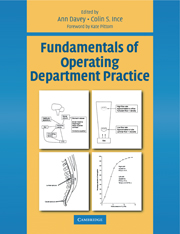Book contents
- Frontmatter
- Contents
- Contributors
- Preface
- Foreword
- Acknowledgements
- Introduction
- Chapter 1 The operating department practitioner, the patient and the law
- Chapter 2 Aspects of health and safety in the operating department
- Chapter 3 The caring practitioner
- Chapter 4 Strategies for infection control in the operating department
- Chapter 5 Sterilization, decontamination and the surgical field
- Chapter 6 The fundamentals of cardiovascular physiology
- Chapter 7 Fundamentals of respiratory physiology
- Chapter 8 Scientific principles in relation to the anaesthetic machine
- Chapter 9 Fundamentals of artificial ventilation of the lung
- Chapter 10 Scientific principles in relation to monitoring equipment
- Chapter 11 Scientific principles in relation to endoscopic, laser and radiological equipment
- Chapter 12 Pharmacological principles of drug administration
- Chapter 13 The pharmacology of drugs used in general anaesthesia
- Chapter 14 The local anaesthetic drugs - does the ideal agent exist?
- Chapter 15 The safe positioning of patients for surgery
- Chapter 16 Principles involved in the management and use of equipment
- Chapter 17 Understanding suture materials
- Chapter 18 Fundamentals ofpaediatric surgery and anaesthesia
- Chapter 19 Fundamentals of hyperthermia and hypothermia
- Chapter 20 Fundamentals of fluid and electrolyte balance during surgery
- Chapter 21 The physiology of blood and its administration
- Chapter 22 Fundamentals of pain relief
- Chapter 23 Fundamentals of dressings and drains in relation to wound healing
- Chapter 24 The recovery of patients from anaesthesia and surgery
- Chapter 25 Fundamentals of emergency and obstetric anaesthesia
- Chapter 26 Identification and management of anaesthetic emergencies
- Chapter 27 The fundamentals of emergency resuscitation
- Appendixes
- Index
Chapter 8 - Scientific principles in relation to the anaesthetic machine
Published online by Cambridge University Press: 05 October 2015
- Frontmatter
- Contents
- Contributors
- Preface
- Foreword
- Acknowledgements
- Introduction
- Chapter 1 The operating department practitioner, the patient and the law
- Chapter 2 Aspects of health and safety in the operating department
- Chapter 3 The caring practitioner
- Chapter 4 Strategies for infection control in the operating department
- Chapter 5 Sterilization, decontamination and the surgical field
- Chapter 6 The fundamentals of cardiovascular physiology
- Chapter 7 Fundamentals of respiratory physiology
- Chapter 8 Scientific principles in relation to the anaesthetic machine
- Chapter 9 Fundamentals of artificial ventilation of the lung
- Chapter 10 Scientific principles in relation to monitoring equipment
- Chapter 11 Scientific principles in relation to endoscopic, laser and radiological equipment
- Chapter 12 Pharmacological principles of drug administration
- Chapter 13 The pharmacology of drugs used in general anaesthesia
- Chapter 14 The local anaesthetic drugs - does the ideal agent exist?
- Chapter 15 The safe positioning of patients for surgery
- Chapter 16 Principles involved in the management and use of equipment
- Chapter 17 Understanding suture materials
- Chapter 18 Fundamentals ofpaediatric surgery and anaesthesia
- Chapter 19 Fundamentals of hyperthermia and hypothermia
- Chapter 20 Fundamentals of fluid and electrolyte balance during surgery
- Chapter 21 The physiology of blood and its administration
- Chapter 22 Fundamentals of pain relief
- Chapter 23 Fundamentals of dressings and drains in relation to wound healing
- Chapter 24 The recovery of patients from anaesthesia and surgery
- Chapter 25 Fundamentals of emergency and obstetric anaesthesia
- Chapter 26 Identification and management of anaesthetic emergencies
- Chapter 27 The fundamentals of emergency resuscitation
- Appendixes
- Index
Summary
WHAT IS AN ANAESTHETIC MACHINE?
All anaesthetics require the supply of respirable gases for the patient to breathe. In current UK practice this gas mixture is usually a major part of the maintenance phase of anaesthesia. Anaesthetic machines are the apparatus used for delivering to the patient this gas mixture in an accurate, controlled and safe manner. Early anaesthesia only made use of inhalational agents and as anaesthesia developed, so did the apparatus. Perhaps one of the earliest advances in this field was regulation of the concentration of anaesthetic vapours and in 1847 John Snow developed ether and chloroform inhalers. It was not until 1910 that E. I. McKesson introduced the first intermittent flow (demand) nitrous oxide and oxygen machine, which was able to determine the concentration of both gases in percentage terms given to the patient. In 1917 Edmund Boyle described a portable apparatus used for the delivery of oxygen and nitrous oxide. This was modified from an American design and was the forerunner of the modern Boyle's machine. Boyle is now a trademark of Ohmeda, formerly the anaesthetic division of the British Oxygen Company (BOC).
UNITS USED IN THE MEASUREMENT OF GAS PRESSURES
The SI unit of pressure is the Pascal (Pa). The CGS unit is the bar (b).
One atmosphere is
760 mmHg = 1b = 1000 mb = 100,000 Pa = 100 kPa = 15 lb/in2 = 1000 cmH2O where mb is short for millibar and kPa for kilopascal.
THE GAS LAWS
Gases obey physical laws, which determine how they must be supplied and used. In any container the molecules of a gas are evenly distributed throughout that container. As the molecules move about they will collide with each other and with the sides of the container and the speed with which the molecules move (and therefore the collision rate) increases with temperature. If more gas is added to the container or the size of the container is reduced, the rate of collision will also increase. The pressure the gas exerts on the container walls is a reflection of the collision rate of molecules with the container walls and with each other.
- Type
- Chapter
- Information
- Fundamentals of Operating Department Practice , pp. 75 - 96Publisher: Cambridge University PressPrint publication year: 1999



